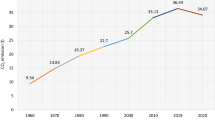Abstract
Alcaligenes sp. MTCC 10674 was isolated as acetone cyanohydrin hydrolyzing bacterium from soil of orchid gardens of Himachal Pradesh. Acetone cyanohydrin hydrolyzing activity of this organism comprised nitrile hydratase and amidase activities. It exhibited higher substrate specificity towards aliphatic hydroxynitrile (acetone cyanohydrin) in comparison to arylaliphatic hydroxynitrile. Isobutyronitrile (40 mM) acted as a carbon source as well as inducer for growth of Alcaligenes sp. MTCC 10674 and expression of acetone cyanohydrin hydrolyzing activity. Optimization of culture condition using response surface methodology increased acetone cyanohydrin hydrolyzing activity by 1.3-fold, while inducer mediation approach increased the activity by 1.2-fold. The half life of this enzyme was 25 h at 15 °C. V max and K m value for acetone cyanohydrin hydrolyzing enzyme was 0.71 μmol mg−1 min−1 and 14.3 mM, when acetone cyanohydrin was used as substrate. Acetone cyanohydrin hydrolyzing enzyme encountered product inhibition and IC50 and K i value were calculated to be 28 and 10.2 mM, respectively, when product α-hydroxyisobutyric acid was added in the reaction. Under optimized reaction conditions at 40 ml fed batch scale, 3 mg dcw ml− resting cells of Alcaligenes sp. MTCC 10674 fully converted 0.33 M acetone cyanohydrin into α-hydroxyisobutyric acid (1.02 g) in 6 h 40 min. The characterization of acetone cyanohydrins hydrolyzing activity revealed that it comprises bienzymatic nitrile hydrolyzing system, i.e. nitrile hydratase and amidase for the production of α-hydroxyisobutyric acid from acetone cyanohydrin and maximum 70 % yield is being reported for the first time.








Similar content being viewed by others
References
Bak S, Paquette SM, Morant M, Morant AV, Saito S, Bjarnholt N, Zagrobelny M, Jorgensen K, Osmani S, Simonsen HT, Perez RS, van Heeswijck TB, Jorgensen B, Moller BL (2006) Cyanogenic glycosides: a case study for evolution and application of cytochromes P450. Phytochem Rev 5:309–329
Nahrstedt A (1996) Relationships between the defensive systems of plants and insect. Recent Advances in Phytochemistry. Plenum Press, New York, pp 217–230
Bhalla TC, Kumar H (2005) Nocardia globerula NHB-2: a versatile nitrile-degrading organism. Can J Microbiol 51:705–708
Bunch AW (1998) Biotransformation of nitriles by R. rhodococci. Antonie Van Leeuwenhoek 74:89–97
Kobayashi M, Shimizu S (1994) Versatile nitrilases: nitrile hydrolysing enzymes. FEMS Microbiol Lett 120:217–224
Martinkova L, Kren V (2002) Nitrile- and amide-converting microbial enzymes: stereo- regio- and chemoselectivity. Biocatal Biotransform 20:73–93
Nagasawa T, Yamada H (1995) Microbial production of commodity chemicals. Pure Appl Chem 67:1241–1256
Rohwerder T, Roland HM (2010) Biosynthesis of 2-hydroxyisobutyric acid (2-HIBA) from renewable carbon. Microb Cell Fact 9:13–22
Singh R, Sharma R, Tiwari N, Geetanjali, Rawart DS (2006) Nitrilase and its application as a ‘green’ catalyst. Chem Biodivers 3:1279–1287
Chauhan (2003) Method for producing 2-hydroxyisobutyric acid and methacrylic acid from acetone cyanohydrin. US 6582943B1
Hoefel T, Wittmann E, Reinecke L, Weuster-Botz D (2010) Reaction engineering studies for the production of 2-hydroxyisobutyric acid with recombinant Cupriavidus necator H 16. Appl Microbiol Biotechnol 88:477–484
Bhalla TC, Miura M, Wakamoto A, Ohba Y, Furuhashi K (1992) Asymmetric hydrolysis of α-aminonitriles to optically active amino acids by a nitrilase of Rhodococcus rhodochrous PA-34. Appl Microbiol Biotechnol 37:184–190
Nagasawa T, Shimizu H, Yamada H (1993) The superiority of the third-generation catalyst, Rhodococcus rhodochrous J1 nitrile hydratase, for industrial production of acrylamide. Appl Microbiol Biotechnol 40:189–195
Prasad S, Sharma DR, Bhalla TC (2005) Nitrile- and amidehydrolysing activity in Kluyveromyces thermotolerans MGBY 37. World J Microbiol Biotechnol 21:1447–1450
Watanabe I, Satoh Y, Enomoto K, Seki S, Sakashita K (1987) Optimal conditions for cultivation of Rhodococcus sp. N-774 and for conversion of acrylonitrile to acrylamide by resting cells. Agric Biol Chem 51:3201–3206
Kobayashi M, Nagasawa T, Yamada H (1989) Nitrilase of Rhodococcus rhodochrous J1: purification and characterization. Eur J Biochem 182:349–356
Xiao ZJ, Liu PH, Qin JY, Xu P (2007) Statistical optimization of medium components for enhanced acetoin production from molasses and soybean meal hydrolysate. Appl Microbiol Biotechnol 74:61–68
Layh N, Hirrlinger B, Stolz A, Knackmuss HJ (1997) Enrichment strategies for nitrile hydrolysing bacteria. Appl Microbiol Biotechnol 47:668–674
Coninck JD, Leclercq B, Exbrayat JM, Duyme F (2004) Factorial designs: an efficient approach to choosing the main factors influencing growth and hydrolase production by Tetrahymena thermophila. J Ind Microbiol Biotechnol 31:204–208
Banerjee A, Kaul P, Banerjee UC (2006) Enhancing the catalytic potential of nitrilase from Pseudomonas putida for stereoselective nitrile hydrolysis. Appl Microbiol Biotechnol 72:77–87
Rezende RP, Carlos J, Dias T, Monteiro AS, Carraza F, Linardi VR (2003) The use of acetonitrile as the sole nitrogen and carbon source. Braz J Microbiol 34:117–120
Kobayashi M, Yanaka T, Nagasawa, Yamada H (1992) Primary structure of an aliphatic nitrile-degrading nitrilase from Rhodococcus rhodochrous K22, and expression of its gene and identification of its active site residue. Biochem 31:9000–9007
Yeom SJ, Kim HJ, Lee JK, Kim DE, Oh DK (2008) An amino acid at position 142 in nitrilase from Rhodococcus rhodochrous ATCC 33278 determines the substrate specificity for aliphatic and aromatic nitriles. Biochem J 15:401–407
Shen M, Zheng YG, Liu ZQ, Shen YC (2009) Production of acrylic acid from Acrylonitrile by immobilization of Arthrobacter nitroguajacolicus ZJUTB06-99. J Microbiol Biotechnol 19:582–587
Prasad S, Raj J, Bhalla TC (2009) Purification of a hyperactive nitrile hydratase from resting cells of Rhodococcus rhodochrous PA-34. Ind J Microbiol 49:237–242
Shen W, Chen H, Kaizhi J, Jun N, Yan X, Li S (2012) Cloning and characterization of a novel amidase from Paracoccus sp. M-1 showing aryl acylamidase and acyl transferase activities. Appl Microbiol Biotechnol 4:1007–1013
Acknowledgments
The authors acknowledge the Department of Biotechnology and University Grant Commission, India for financial support in the form of Senior Research Fellowship to Mr. Shashi Kant Bhatia, Praveen Kumar Mehta and Ravi Kant Bhatia. The computational facility availed at Bioinformatics Centre, H P University is also duly acknowledged.
Author information
Authors and Affiliations
Corresponding author
Rights and permissions
About this article
Cite this article
Bhatia, S.K., Mehta, P.K., Bhatia, R.K. et al. An isobutyronitrile-induced bienzymatic system of Alcaligenes sp. MTCC 10674 and its application in the synthesis of α-hydroxyisobutyric acid. Bioprocess Biosyst Eng 36, 613–625 (2013). https://doi.org/10.1007/s00449-012-0817-y
Received:
Accepted:
Published:
Issue Date:
DOI: https://doi.org/10.1007/s00449-012-0817-y




